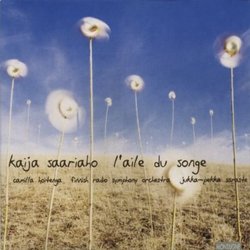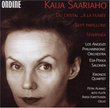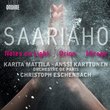| All Artists: Kaija Saariaho, Jukka-Pekka Saraste, Finnish Radio Symphony Orchestra Title: Kaija Saariaho: L'aile du songe Members Wishing: 3 Total Copies: 0 Label: Disques Montaigne Release Date: 11/12/2002 Genres: Special Interest, Classical Styles: Chamber Music, Forms & Genres, Concertos, Instruments, Reeds & Winds, Symphonies Number of Discs: 1 SwapaCD Credits: 1 |
Search - Kaija Saariaho, Jukka-Pekka Saraste, Finnish Radio Symphony Orchestra :: Kaija Saariaho: L'aile du songe
 | Kaija Saariaho, Jukka-Pekka Saraste, Finnish Radio Symphony Orchestra Kaija Saariaho: L'aile du songe Genres: Special Interest, Classical
|
Larger Image |
CD DetailsSimilar CDs |
CD ReviewsTwo bold works--one a masterpiece--with a little dead weight Christopher Culver | 10/08/2006 (4 out of 5 stars) "The Finnish composer Kaija Saariaho has long had a fascination with the works of the French poet Saint-John Perse, and innumerable pieces take their titles and inspiration from him: "Neiges", "Amers", "Pres", "Couleurs du vent" just to name a few. This Naive disc, rather irritatingly unavailable domestically in the U.S., features three works all based on Perse's adoration of the majesty of the bird. Two pieces have a spotlight on the flute, performed here by Camilla Hoitenga, who has long worked closely with Saariaho. "Laconisme de l'aile" (1981-82) is one of Saariaho's earliest pieces. It opens with the flautist reciting an extract from Saint-John Perse's "Oiseaux" before commencing. In common with the large number of songs she wrote in this era (a genre generally neglected afterward), the music displays outright melody and simple dramatic gestures. The piece is admirable in that it has a fairly simple line while nonetheless managing to explore all manner of flute possibilities. Saariaho attempts to follow the text in having the flute imitate the nature of the consontants and vowels of Perse's poem. While certainly earlier Saariaho, it's a confident piece, and I enjoy it quite a bit. We pass over twenty years between this piece and the flute concerto "L'aile du songe" (2001). Saariaho encountered the spectralist school of composers, began to use electronics (she established an association with IRCAM) and set her focus on the otherworldly possibilities of timbre, and all in all her writing grew more confident and impressive. Her orchestral diptych "Du cristal ...a la fumee" and the mysterious cello concerto "Amers" are some of the triumphs of this period. Yet, around the middle of the 1990s her work began to lessen, with banal writing like "Chateau de l'ame" and "Oltra Mar". Her beautiful opera "L'amour de loin" is much more memorable for its elegant libretto by Amin Maalouf than for its music. She started to return to form with "Sept papillons" for solo cello and "L'aile du songe" continues this comeback; it is one of the most entertaining flute concertos I've encountered. Split into two parts, it evokes the bird as inhabitant of both earth and air, and actual birds make an appearance in the form of sound samples issued by the electronics. "Aerienne", movements one through three, is made up of a smooth and mysterious harmonic tapestry broken by small jabs and trills by the flute. The wide expanse of sound audible here is simply beautiful. In the second part, "Terrestre", movements four and fives, the scene changes drastically. Here we find dance-like rhythms, with scintallating xylophone and, strikingly, the flautist producing phonetic material in between flute notes. Fans of modern-classical music may know something of what to expect from Toru Takemitsu's "Voice", a much earlier work where the flautist speaks through the instrument, but here the technique is much more vastly employed. After the climax in the fourth movement, we find a synthesis in the last. The performance by Hoitenga and the Finnish Radio Symphony Orchestra conducted by the Finnish Radio Symphony Orchestra is of the highest degree The third "piece" represented on the disc is much different than the other two. "Oiseaux" is one of Saariaho's "sound environments", long, subdued electroacoustic works that are destined more for the background sound of a museum than as part of a concert programme. Over a quiet and gently shifting ambience we hear selections from Saint-John Perse's book that gives the piece its title. The first time it appears on this disc, it is read by the Lebanese-French novelist and occasional Saariaho collaborator Amin Maalouf. The second time it is read by Camilla Hoitenga. Even if the musical substance is slight indeed, Maalouf's reading is fairly entertaining. Hoitenga, however, sounds very awkward indeed, totally unprepared for the art of narration. The recording quality of this disc is of the highest degree. The liner notes are very informative and contain an analysis of the works, together with Saariaho's own remarks about them, as well as the text of the portions used from Perse's "Oiseaux" in French and English translation. All in all, while the flute works here are excellent, the collection as a whole is less appealing than others because of the unremarkable sound environment "Oiseaux". If you are unfamiliar with Saariaho's work, try collecting the various offerings on Ondine first. Still, fans of the composer should seek out this Naive disc, even if the import price doesn't seem all that appealing, since the flute concerto is one of her best works." Excellent new flute works from Saariaho Christopher Culver | 06/27/2003 (5 out of 5 stars) "I almost gave this 4 stars, because two of the pieces on this disc consist of taxing spoken word recordings of poems by Saint-John Perse, one set of five in French, and then the other in English. The "sonic environments" created for these are interesting and darkly beautiful, and perhaps without the narration would've been stunning. But I have a dislike for spoken word pieces, especially in English, which just doesn't sound right for some reason.
However, the two flute pieces, Laconisme de l'aile and L'Aile du songe are worth getting the album for! The first is solo flute with weird, hushed whisperings of yet another poem by Saint-John Perse, but is more surreal and haunting. The second piece is for flute and orchestra and is pure Saariaho. Large drifting pieces of musical colour, horror, awe, and beauty. It seems difficult to find this CD, though, so good luck!" |

 Track Listings (18) - Disc #1
Track Listings (18) - Disc #1
